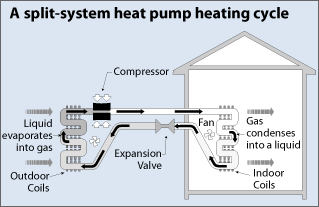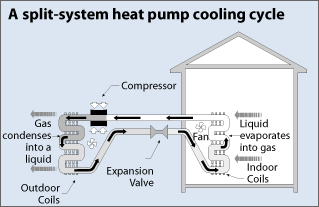Air Source Heat Pumps
Electric air-to-air heat pumps are basically reversible air conditioners. They move heat from the air in one location to the air in another. In summer, they operate as air conditioners, removing heat from the home. In winter, they reverse their operation, gathering heat from air outside the home and moving it inside. Most heat pumps deliver conditioned air to the home using ductwork, although packaged, through-the-wall systems with no duct work are available.
Since heat pumps move rather than generate heat, they can be extremely efficient, delivering more than three times as much heat as they consume in energy. In some parts of the country, especially in mild climates, they are the least expensive way to heat and cool a home. Heat pumps have the additional advantages of providing heating and cooling in one unit using a single energy source. In addition, heat pumps do not require flues nor their associated roof penetrations.
Heat pump efficiency depends on outdoor temperature. In the heating mode, performance drops as the outside air temperature drops. In cold climates, heat pumps require a supplemental heating system for when they cannot produce enough heat to maintain the desired indoor temperature. Electric resistance back-up is most common, but gas, oil and LP gas back-up heating systems can also be used.
Federal efficiency standards require that conventional heat pumps have an HSPF rating of at least 6.8 and a SEER rating of at least 13.0. The most efficient air source heat pumps have an HSPF rating between 8.5 and 10.0 and a SEER above 16 or so.
 
(graphics courtesy U.S. Dept. of Energy)
Questions About Conventional Heat Pumps (Air to Air) ... |
WHAT IS A HEAT PUMP?
A heat pump is an efficient method of cooling your home in summer and warming it in winter. Although heat pumps are new to many people, they’ve been around for over three decades, and are found in schools, offices, motels, stores and industrial plants as well as homes.
WHY CHOOSE A NEW HEAT PUMP?
A new energy efficient heat pump is a good investment, providing years of worry-free heating and cooling and significant savings on your electric bill.
HOW A HEAT PUMP WORKS
A heat pump works by moving heat. In the summer, a heat pump operates like a standard electronically driven air conditioner, collecting heat from the air in your home and expelling it outside.
In winter, the process is reversed, and the heat pump collects heat from outdoor air to warm the air inside your home.
HOW DOES IT WORK IN WINTER?
“You’re saying that when it’s thirty-eight degrees outside, my heat pump can still take enough heat out of the air to warm my home?” Right. Even the coldest winter air contains some heat. However, heat pumps work best at temperatures above 35 degrees Fahrenheit.
Below this temperature, an electrical resistance heater switches on, if required, to supplement heat brought in from outside.
HOW WELL DOES IT WORK?
While many people find the winter operation of a heat pump the most difficult understand, it is during the heating cycle that the heat pump produces the most significant savings.
Unlike a furnace, that turns fossil fuel or electricity into heat, the heat pump collects heat that already exists in the outdoor air by means of its refrigeration cycle. Consequently, your heat pump will produce 2 to 3 times more heat than the energy it uses!
HOW MUCH MONEY CAN I SAVE?
Savings depend upon four factors:
-The efficiency of your old equipment
-The efficiency of your new heat pump
-Your climate
-Your electric rate
SAVE ON COOLING!
Cooling efficiency is rated by SEER (Seasonal Energy Efficiency Ratio). The higher the SEER, the higher the savings. If your home is over eight years old, your current air conditioner or heat pump probably has a SEER of 7.0. A new, higher efficiency heat pump can be as much as 56% more efficient.
SAVE ON HEATING!
Heat pumps are rated for heating efficiency by HSPF (Heating Seasonal Performance Factor). Heat pumps are available with HSPF ratings up to 9.0. Since a heat pump combines the heat it produces with the heat from outside, the coefficient of performance (COP) of a heat pump is more than one. This means, you may pay for a dollar’s worth of electricity, but a heat pump can deliver as much as $3.45 worth of heating. That’s quite a bargain!
GIVE ME MY SAVINGS IN DOLLARS!
If you lived in a three bedroom home in mid-American city and had an older heat pump or air conditioner with a SEER of 7.0, replacing it with a high-efficiency heat pump with a SEER of 12.0 could save you $668 over a three-year period.
DUAL FUEL
If you’re looking for a new cooling system, but your old non-electric furnace is still working, consider buying an add-on heat pump. With a dual fuel system, the two systems share the heating load, but never at the same time. Each system operates when it is the most cost effective.
In a dual fuel system, the heat pump will be your cooling system in the summer and your primary heat source in winter. But when the temperature drops below the heat pump’s set point, your furnace will take over until the outside temperature rises enough for the heat pump to operate more efficiently than your old furnace.
|
|
